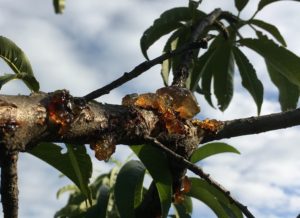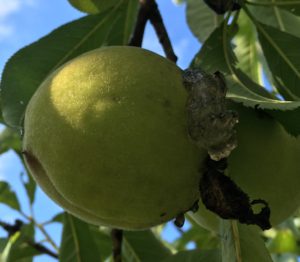Hello fellow readers,
Jeanne of Blairstown NJ shared a gooey dilemma on her peach trees. Both trees have clear jelly-like globs on or near the fruit. Plus, a rust colored goo on some of the branches. One tree has a deep wound at the base of the trunk, yet that’s the tree producing edible fruit; though spotted with grey freckles.
I read that after a heavy rain, peach and other stone fruit trees can ooze jelly; especially after a long dry spell. It’s clear and gelatin-like which describes part of Jeanne’s dilemma, though I have yet to hear what causes it. Moisture overload after being excessively dry perhaps? A jelly-like substance can also be honeydew secreted by aphids. If there’s a plethora of ants around the tree it’s a sure sign. (Recall Craig’s Willow’s Gone Wild 2-part dilemma?)

Gooey evidence of Cytospora Canker (aka Perennial Canker): one of the most destructive diseases of peaches and other stone fruits
Then there’s Gummosis which is the oozing sap from wounds or cankers. It can result from environmental stress such as drought, injury from equipment, or caused by insects or disease. Penn State University writes that Cytospora Canker is one of the most destructive diseases of peaches and other stone fruits; causing young trees to die and older trees to decline. It’s also known as Perennial Canker. You can tell the goo is not from insects or injury as the weepy orange or rust-colored sap has no bits of bark or sawdust in it.
Perennial Canker disease is an airborne fungus that enters the tree through damaged bark. At the point of entry, a sunken canker forms that then may become covered with a black fungus. The disease gradually spreads, eventually killing everything beyond the initial canker. While once infected there is no cure, it can be managed to some extent by removing the diseased branches four inches below the sap. Disinfect pruners after each cut and dispose the debris in a way that won’t infect other plants.
Back to Jeanne’s freckled fruit. It’s likely another fungus known as Peach Scab. Clearly her peach trees have multiple issues which often happens; just as with people when under stress. And, just like our health and wellness, prevention is the key.
Prevent injury from lawnmowers by keeping mower blades high around roots and mow so debris shoots away from the tree. Keep weed trimmers clear from trunks too. Deep root watering during dry spells and fertilizing in late winter or early spring will help trees ward off disease. Prune dead or damaged branches to prevent an entry point for invaders. And, while you’re at it, do your best to eliminate your own stress. Breath green with a splash of color!
Garden Dilemmas? Askmarystone@gmail.com
Tip: I learned the following peach tree varieties are more resistant to fungal disease include: Prunus persica ‘Bisco’, ‘Carmen’, ‘Champion’, ‘Harvelle’, ‘Jayhaven’, ‘Redqueen’, Reliance’, or ‘Veteran’.



